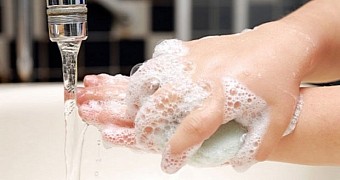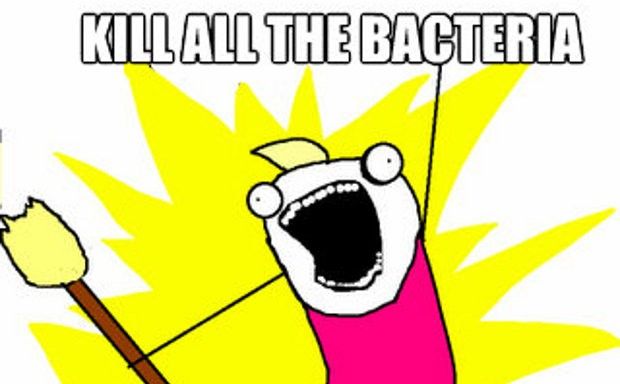Germs - one of our biggest foes since the beginning of time. True, there are good bacteria, like the ones that live in our guts and help us digest food, but there are also bad ones.
For starters, there are those that cause respiratory infections. Strains of mycobacteria, which cause tuberculosis, are estimated to kill around 2 million people each year.
Then there's the bacterium behind cholera, Vibrio cholerae. Syphilis, leprosy and bubonic plague are too infectious diseases brought about by such nasty microorganisms.
So, yes, not all bacteria are our friends. Some are out to get us and it's no wonder we're willing to do just about anything to keep them off our backs. And our hands, legs and whatever other body parts we have.
Anti-bacterial soaps to the rescue, kind of
These days, we have dozens of anti-bacterial soaps, dish detergents, shampoos, gels and whatnot to pick and choose from. There are so many of them you'd think germ-fighting home products have been around for centuries. Except they haven't.
Dial soap, the first anti-bacterial soap in the history of personal hygiene, was introduced in 1948. Dial hand soap and other related products are presently manufactured by the Dial Corporation, a Henkel subsidiary based in Arizona, US.
When Dial made its debut, its makers advertised it as being designed to kill skin bacteria and, in doing so, do away with unpleasant perspiration odors. The compound that gave the soap its bacteria-killing abilities was hexachlorophene.
Now, it might be that hexachlorophene did a pretty good job killing bacteria, but the fact of the matter is it wasn't exactly people-friendly. In 1972, the US Food and Drug Administration banned products containing more than 1% hexachlorophene.
This happened after the compound was linked to several dozen deaths resulting from brain damage. Apparently, hexachlorophene wasn't all it was cut out to be. It did a fine job killing bacteria, but it also took its toll on people's health.
Keep the soap, change the anti-bacterial ingredient
With hexachlorophene out of the picture, another anti-bacterial compound rose to fame: triclosan. Around 75% of the liquid hand soaps and 30% of the soap bars marketed as anti-bacterial contain this compound. It's also added to many other home products.
Described by specialists as anti-bacterial and anti-fungal agent, it was widely used as a hospital disinfectant back in the 1970s. Then, following the ban on hexachlorophene, it was added to soaps in concentrations of 0.1 to 1%.
As noted, many of the home products we buy and use contain triclosan. Apart from anti-bacterial soaps, the compound is used to make toothpaste, mouthwash, deodorants, shampoos and cleaning gels. Mind you, it's also used to sanitize toys and even bedding.
As popular as it is, we don't know much about it
The funny thing about triclosan is that, as widely used as it now is, we don't really know all that much about it. Which brings us to our point: perhaps anti-bacterial soaps, gels and whatnot aren't the best use for your money.
As mentioned, triclosan has been used to make anti-bacterial home products for several decades now. However, it was only towards the end of 2013 that the US Food and Drug Administration produced a report on the benefits and the risks that come with exposure to this compound.
Although years in the making, this report merely concluded that there wasn't enough evidence that soaps made with triclosan were in any way preferable to regular ones, and mentioned that the compound might, in fact, be a health risk.
“There currently is no evidence that over-the-counter (OTC) antibacterial soap products are any more effective at preventing illness than washing with plain soap and water,” the agency said.
“Antibacterial soap products contain chemical ingredients, such as triclosan and triclocarban, which may carry unnecessary risks given that their benefits are unproven,” it went on to explain.
Having published this report, the US Food and Drug Administration ordered that companies making such home products bring evidence in support of their claims that their germ-fighting soaps are indeed the better alternative. This is yet to happen.
Evidence is actually piling up against anti-bacterial soaps
The folks making and marketing anti-bacterial soaps containing triclosan as their chief bacteria-killing ingredient might have remained silent on the topic, but several studies have hinted that exposure to this compound correlates with developmental issues, reduced fertility and even cancer.
Earlier this week, a team of specialists published the results of an investigation showing that anti-bacterial soaps made with triclosan don't really kill more bacteria than regular ones, not unless people wash their hands with warm water for about 9 hours straight.
Besides, there's talk among scientists that the use of anti-bacterial soaps can give rise to anti-biotic resistant bacteria. Thus, exposure to triclosan could force bacteria into undergoing mutations allowing them to survive the compound. This would make for stronger bacteria.
Then, one other problem with soaps and home products containing triclosan is that they are a threat to the environment. The more popular such products get and the more people use them, the more of this compound gets flushed down our drains and ends up accumulating in ecosystems.
Bottom line, anti-bacterial soaps, shampoos, gels and the like really aren't all they're cut out to be. Sure, they might look good on paper, but the fact remains that, at least until we have definite proof they are in no way a threat to us, perhaps we should stop buying them.
Or, if we absolutely must, scientists say we should choose the ones containing alcohol as a disinfecting agent. The ones made with triclosan are, at least for now, too much of a gamble.

 14 DAY TRIAL //
14 DAY TRIAL // 



